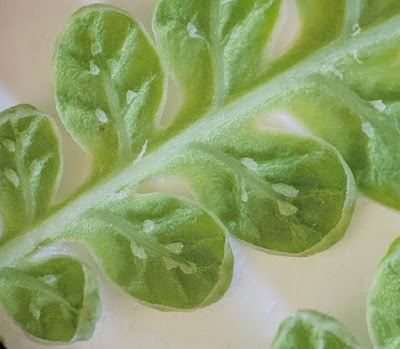 |
| "... the fertile ones being so unlike the sterile, that no one who is unacquainted with the plant would suppose they had anything to do with each other." Photo by peganum. |
First, let's be clear what ferns are (I needed this, Botany 101 being but a faint memory). Personally I think it's easier to describe what they're not. Ferns are neither mosses nor seed plants.
Ferns are like mosses in that they reproduce via spores. But unlike mosses, they have vascular tissue—pipe-like cells for transporting water and minerals through the plant. Because of this plumbing they're classified as vascular plants—tracheophytes. While mosses stay low to be near moisture, ferns can grow tall, even tree-size.
 |
| Brush Pot Tree (Sphaeropteris lepifera), a fern reaching for the sun. Photo by AraucariaHeterophylla. |
 |
| Evolutionary diagram for plants; ferns and "Fern Allies" in green box. Geeks can click on image to view details (modified from source). |
 |
| Sensitive Fern, Onoclea sensibilis. By rawpixel. |
Especially interesting are the leaves. There are two kinds and they differ dramatically, as pteridologist Daniel Cady Eaton explained (1881): "The fronds [leaves] are truly dimorphous, the fertile ones being so unlike the sterile, that no one who is unacquainted with the plant would suppose they had anything to do with each other." I agree!
The sterile leaves look like fern leaves—green and several times lobed. They're the basis for "Sensitive" as Eaton explained: "The fronds wilt very soon after plucking them ... The first frost of autumn destroys the sterile fronds; and a late frost in May or June does the same."
 |
| Sterile leaf of the Sensitive Fern. Photo by jillllybean. |
In stark contrast, the fertile leaves are very odd! "The fertile fronds are not very common, and a young botanist may search in vain for them for a long time. ... They are nearly black in color ... [and] divided into a double row of sub-globose bead-like segments or pinnules; the whole looking like a small and narrow but dense cluster of diminutive grapes" (Eaton again).
No wonder Bead Fern is another common name. The beads are made of tightly rolled-up leaflet lobes, protecting spores waiting to fly in spring.
 |
| Sensitive/Bead Fern's curious fertile leaf (MWI). |
 |
| Fertile leaves standing after sterile have wilted; var. interrupta, Japan. Photo by Aomorikuma. |
 |
| Onoclea sensibilis from Eaton 1881. Emerton, JH, & Faxon, CE, illustrators. |
 |
| Mystery leaf up close; arrows point to examples of possible sori ("spore clusters" for now). |
"The leaf in the lower right is more highly cut (1-pinnate-pinnatifid), and such leaves are often produced late in the year, usually in response to trauma from mowing or a late frost. Sometimes these leaves represent a part-sterile and part-fertile condition, being developmentally intermediate between the two extremes of the normal sterile and fertile leaves ... " (2).With that mystery solved, we move on to spore dispersal. In Ferns of North America (also by Eaton, 1879–80) the Sensitive Fern plate includes an opened bead filled with what look like tinier beads. These are sporangia, which contain the even tinier spores (dust-sized!).
Intermediate leaves "often are produced in response to frost or mowing late in the season, although they also occur naturally without disturbance." (© Robbin Moran 2021)
Note elongate indusiate sori [spore clusters with little flap-like covers] (© Robbin Moran 2021). Oval lobes are maybe 5 mm long (my ball-park estimate).
 |
| Open Sensitive Fern bead showing lobes and reproductive structures; when rolled up, beads are 2–6 mm long. From Plate LXXII in Eaton 1879–80. |
 |
| Sensitive Fern in winter. Photo by Cephas. |
That's so boring! Many ferns shoot their offspring out into the world, but not the Sensitive Fern. Sorry. The excitement of spore-shooting will have to wait for a future post.
 |
| Original source not given. |
Notes
(1) Dimorphic sterile/fertile leaves are not unique to Onoclea sensibilis, but its leaves "differ drastically" (Beital et al. 1981).
(2) In the past, plants with intermediate sterile-fertile leaves have been recognized as a distinct species, a variety or a taxonomic form (e.g., Onoclea obtusilobata). Beital et al. (1981) showed none of these are valid. See also Flora North America.
Sources in addition to links in post
Beital, JM, Wagner, WH Jr., Walter,KS. 1981. Unusual frond development in Sensitive Fern, Onoclea sensibilis L. American Midland Naturalist 105:396-400. https://www.jstor.org/stable/2424762
Eaton, DC. 1879–80. The ferns of North America ... v. 2. Emerton, JH, & Faxon, CE, illustrators. Onoclea sensiblis Plate XII, pages 195–200. BHL
Eaton, DC. 1881. Beautiful ferns from original water-color drawings after nature. Emerton, JH, & Faxon, CE, illustrators. Onoclea sensiblis pages 153–158 & preceding plate. BHL
Moran, RC. 2004. The Natural History of Ferns. Timber Press.
Pinson, Jerald. About Ferns. American Fern Society (accessed 9 Feb 2025).
Suissa, JS. 2022. Fern fronds that move like pine cones: humidity-driven motion of fertile leaflets governs the timing of spore dispersal in a widespread fern species. Annals of Botany 129:519-528. https://doi.org/10.1093/aob/mcab137 (open access).


Excellent. Thanks.
ReplyDeleteThis was great, ferns are fascinating - and I truly don't know much about them. I especially find the fertile front intriguing!
ReplyDeleteThanks, tz! I'm glad you enjoyed it.
DeleteWow, thanks for all this: I learned so much. I have so many ferns here in the garden and I'm a huge fan. Now I'm yearning for their unfurling in spring...
ReplyDeleteBeth—thank YOU for the encouragement! I hope to see some of your ferns on PlantPostings :)
Delete